03 Nov 2020
Seizure-related 6 homolog like 2 autoimmunity
Authors:
Jon Landa, Mar Guasp, Mar Petit-Pedrol, Eugenia Martínez-Hernández, Jesús Planagumà, Albert Saiz, Raquel Ruiz-García, Lorena García-Fernández, Jan Verschuuren, Rachel Saunders-Pullman, Liliana Ramirez-Gómez, Michael D. Geschwind, Josep Dalmau, Lidia Sabater, Francesc Graus
Abstract
Objective
To describe the clinical syndrome of 4 new patients with seizure-related 6 homolog like 2 antibodies (SEZ6L2-abs), study the antibody characteristics, and evaluate their effects on neuronal cultures.
Methods
SEZ6L2-abs were initially identified in serum and CSF of a patient with cerebellar ataxia by immunohistochemistry on rat brain sections and immunoprecipitation from rat cerebellar neurons. We used a cell-based assay (CBA) of HEK293 cells transfected with SEZ6L2 to test the serum of 95 patients with unclassified neuropil antibodies, 331 with different neurologic disorders, and 10 healthy subjects. Additional studies included characterization of immunoglobulin G (IgG) subclasses and the effects of SEZ6L2-abs on cultures of rat hippocampal neurons.
Results
In addition to the index patient, SEZ6L2-abs were identified by CBA in 3/95 patients with unclassified neuropil antibodies but in none of the 341 controls. The median age of the 4 patients was 62 years (range: 54–69 years), and 2 were female. Patients presented with subacute gait ataxia, dysarthria, and mild extrapyramidal symptoms. Initial brain MRI was normal, and CSF pleocytosis was found in only 1 patient. None improved with immunotherapy. SEZ6L2-abs recognized conformational epitopes. IgG4 SEZ6L2-abs were found in all 4 patients, and it was the predominant subclass in 2. SEZ6L2-abs did not alter the number of total or synaptic SEZ6L2 or the AMPA glutamate receptor 1 (GluA1) clusters on the surface of hippocampal neurons.
Conclusions
SEZ6L2-abs associate with a subacute cerebellar syndrome with frequent extrapyramidal symptoms. The potential pathogenic effect of the antibodies is not mediated by internalization of the antigen.

